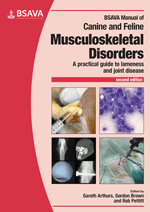
Full text loading...

The stifle joint is a complex hinge joint consisting of distinct femorotibial and femoropatellar articulations. This chapter discusses the clinical anatomy, examination, diagnosis and management of a wide range of diseases affecting the stifle. Quick Reference Guide to Imaging Techniques by Thomas W. Maddox. Operative Techniques: Patient preparation for stifle surgery; Lateral parapatellar approach; Medial parapatellar approach; Intra-articular stifle joint inspection; Meniscal inspection, partial meniscectomy and medial meniscal release; Crimped lateral fabellotibial suture; Tibial tuberosity transposition; Recession trochleoplasty; Tibial osteotomy procedures – Editor’s guide.
The stifle, Page 1 of 1
< Previous page | Next page > /docserver/preview/fulltext/10.22233/9781910443286/9781910443286.23-1.gif

Full text loading...

























































